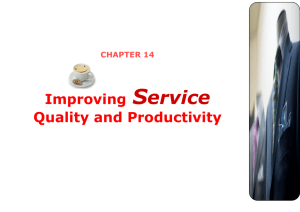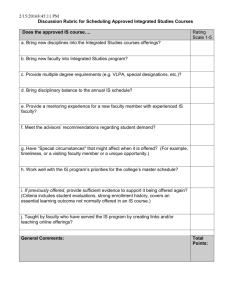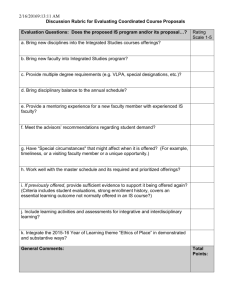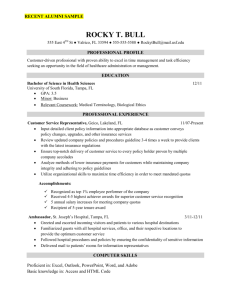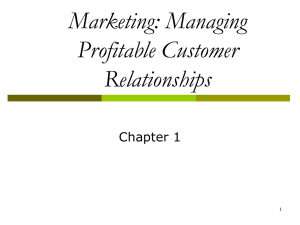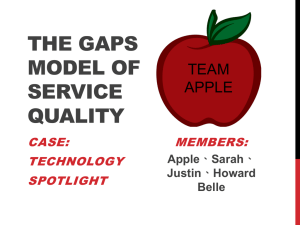Creating Customer-Oriented Companies
advertisement
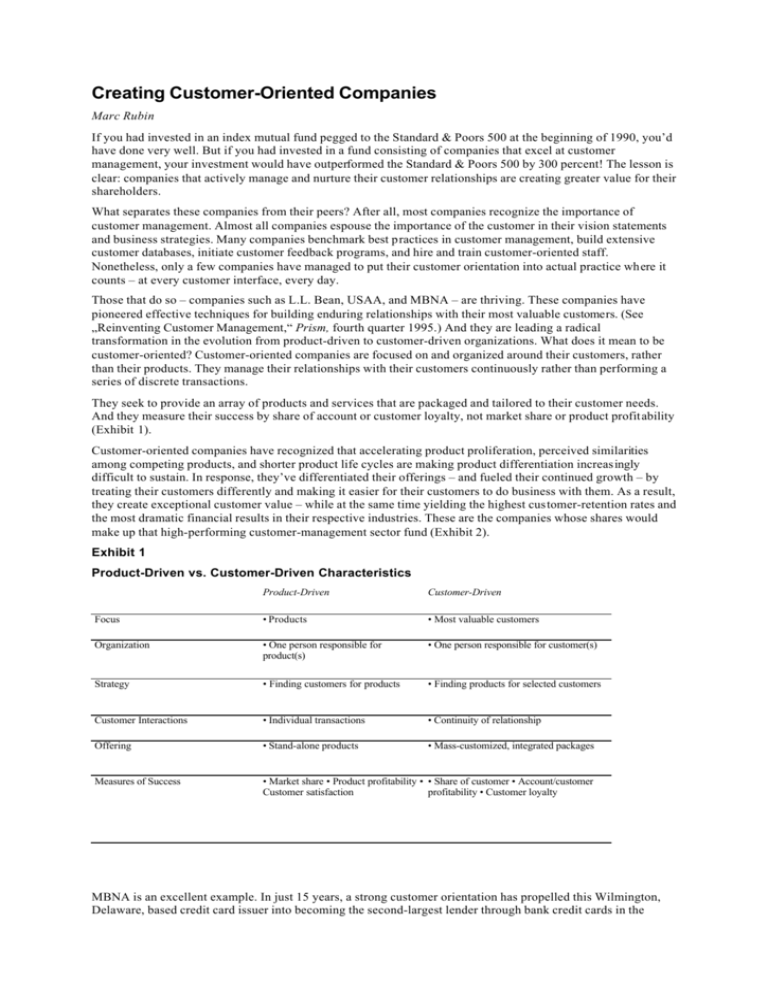
Creating Customer-Oriented Companies Marc Rubin If you had invested in an index mutual fund pegged to the Standard & Poors 500 at the beginning of 1990, you’d have done very well. But if you had invested in a fund consisting of companies that excel at customer management, your investment would have outperformed the Standard & Poors 500 by 300 percent! The lesson is clear: companies that actively manage and nurture their customer relationships are creating greater value for their shareholders. What separates these companies from their peers? After all, most companies recognize the importance of customer management. Almost all companies espouse the importance of the customer in their vision statements and business strategies. Many companies benchmark best practices in customer management, build extensive customer databases, initiate customer feedback programs, and hire and train customer-oriented staff. Nonetheless, only a few companies have managed to put their customer orientation into actual practice where it counts – at every customer interface, every day. Those that do so – companies such as L.L. Bean, USAA, and MBNA – are thriving. These companies have pioneered effective techniques for building enduring relationships with their most valuable customers. (See „Reinventing Customer Management,“ Prism, fourth quarter 1995.) And they are leading a radical transformation in the evolution from product-driven to customer-driven organizations. What does it mean to be customer-oriented? Customer-oriented companies are focused on and organized around their customers, rather than their products. They manage their relationships with their customers continuously rather than performing a series of discrete transactions. They seek to provide an array of products and services that are packaged and tailored to their customer needs. And they measure their success by share of account or customer loyalty, not market share or product profitability (Exhibit 1). Customer-oriented companies have recognized that accelerating product proliferation, perceived similarities among competing products, and shorter product life cycles are making product differentiation increasingly difficult to sustain. In response, they’ve differentiated their offerings – and fueled their continued growth – by treating their customers differently and making it easier for their customers to do business with them. As a result, they create exceptional customer value – while at the same time yielding the highest customer-retention rates and the most dramatic financial results in their respective industries. These are the companies whose shares would make up that high-performing customer-management sector fund (Exhibit 2). Exhibit 1 Product-Driven vs. Customer-Driven Characteristics Product-Driven Customer-Driven Focus • Products • Most valuable customers Organization • One person responsible for product(s) • One person responsible for customer(s) Strategy • Finding customers for products • Finding products for selected customers Customer Interactions • Individual transactions • Continuity of relationship Offering • Stand-alone products • Mass-customized, integrated packages Measures of Success • Market share • Product profitability • • Share of customer • Account/customer Customer satisfaction profitability • Customer loyalty MBNA is an excellent example. In just 15 years, a strong customer orientation has propelled this Wilmington, Delaware, based credit card issuer into becoming the second-largest lender through bank credit cards in the United States, with more than $3 5 billion in managed loans. Its customers use their cards more often, spend 50 percent more per transaction, carry balances that are 60 percent higher, and represent losses less than one-third the industry average. Since 1990, MBNA has increased its market share from 4 to 9 percent and increased its earnings 26 percent annually. And its shareholders consistently enjoy annual returns on equity above 30 percent! MBNA carefully selects its customers by marketing through affinity groups such as associations and universities to attract inherently loyal customers and tailoring its offerings based on the customer’s expected lifetime value. It manages its backroom and customer interface processes to deliver on what customers and their affinity partners say is important. MBNA also leverages detailed customer information to target customers for promotions and to anticipate defectors. Those that try to defect are transferred to a specially trained recovery SWAT team that retains 50 percent of the customers referred. And MBNAs culture continually emphasizes the importance of the customer. For example, executives answer or listen to customer calls for four hours/month. There are signs over the doors in every room – and notes on every pay envelope – reminding MBNA employees that customers are the source of their success. And employee rewards are linked to customer needs. Exhibit 2 Financial Performance of the ADL Best of the Best Companies in Customer Management USAA, another universally recognized leader in customer management, was founded in San Antonio, Texas, in 1922 by a group of army officers to provide insurance to military officers and their families. Like MBNA, the company selected an inherently loyal base of customers. It then built a nontraditional channel to the market: mail and telephone rather than local agents. The company focuses on building customer relationships through worldclass customer service. By leveraging technology to create a near-paperless office, and by providing a desirable work environment and twice the industry average in training, USAA is able to retain a front-line staff that is well positioned to satisfy each of its customers at every point of interface. USAAs customers have been quoted as saying, „USAA owns by relationship.“ The company has leveraged its customer orientation to become the fourth-largest homeowner’s insurance provider, the fifth-largest auto insurer, and the largest mail order company in the United States. It retains over 96 percent of its insurance customers, compared to an industry average of only 85 percent for property and casualty insurance and 89 percent for life insurance. While this $5 billion company is privately owned, a recent Standard & Poors report suggests that its aftertax return on revenue approaches 10 percent. To better understand the keys to success, as well as the barriers companies face in implementing their customer orientation, Arthur D. Little recently conducted a survey of more than 130 major U.S. corporations representing the utilities, chemicals, pharmaceuticals, telecommunications, metals, resources, and oil and gas industries. The survey confirmed these companies’ mixed but generally negative experience in implementing a customer orientation. For almost 60 percent of the responding organizations, customer management is one of the top three corporate initiatives. Yet fewer than one in four firms believe they manage customer relationships effectively – and fewer than one-third believe it’s easy for customers to do business with them. Why is customer orientation so hard to implement? And how do successful firms get it right? In our work with leading companies in several industries, we’ve observed that truly customer-oriented companies share at least two attributes. First, customer orientation is driven from the top. In virtually every case, the leader of the organization has embraced and promoted the customer-driven philosophy. Second, successful execution arises from the effective integration of strategy, operations, and culture. Leading companies begin by creating winning customer-driven strategies to achieve their business objectives. Then they ensure that their operations deliver the desired customer experience. At the same time, they instill a culture in which front-line employees are trained and motivated to satisfy customers at every point of contact. Our survey confirmed the importance of all three elements. When asked to describe the single greatest obstacle to implementing customer orientation, 34 percent of the respondents mentioned their inability to formulate customer-driven strategies, 50 percent cited their inability to operate with excellence before the customer, and 16 percent mentioned difficulties in creating customer-driven cultures. Successful implementation of a customer orientation requires the balanced alignment of all three components. Arthur D. Little has developed a customer management framework that embodies the principles of this integration (Exhibit 3). In using this framework, the goal is to expand the central shaded area, which represents alignment among the company’s customer-oriented strategy, operations, and culture. Customer-Driven Strategy The first component of the model is a cogent customer-driven strategy that defines to whom the company will sell, what it will offer, and why customers will buy it. Exhibit 3 The ADL Customer Management Framework Targeting Customers. Leading companies are very effective at targeting their most valuable customers and communicating priorities throughout their organizations. These companies segment customers at increasingly granular levels to ensure that their offerings and promotions meet individual customer needs (Exhibit 4). Customers are segmented on the basis of their buying needs/behaviors and their lifetime value. Buying needs or behaviors fall into categories such as price shoppers, inherently loyal, or service seekers. Such categories are more relevant than demographic segmentation when developing customer-specific offerings and formulating effective acquisition and retention strategies. For example, USAA targets inherently loyal military officers and their families to generate the impressive retention rates discussed earlier. State Farm targets better-than-average drivers who value personalized service from a local agent. This focus allows State Farm to offer low competitive prices while retaining some of the best-trained, highest-paid agents in the industry. Both contribute to the company’s 90 percent customer retention rate, the highest among insurance companies that sell through agents, and one of the highest capitalization rates in the insurance industry. One wireless company we recently worked with in Europe is focusing on microsegments, such as independent plumbers. The firm tailors promotional messages to their distinct needs, emphasizing, for example, the benefits of higher sales from fewer missed calls or second incomes from spouses who can be released from dispatch duties. At the most granular level, companies such as Levi Strauss, Streamline, and Maxell Corporation have built a sustainable competitive advantage by dealing with their customers on a one-to-one basis, mass customizing women’s jeans, shopping services, and packaging, respectively, to meet the unique needs of each individual customer. Exhibit 4 Granularity of Segmentation The other dimension of segmentation is lifetime value. A customer’s lifetime value is determined by the net present value of his or her expected purchases and referrals over the lifetime of the relationship, offset by the cost to acquire and serve them. Leading companies adjust their customer investments to correspond with the relationships’ expected lifetime value, thus building customer loyalty without diluting shareholder value. Federal Express recently began to segment its customers by value in addition to needs and category of product shipped. The company then develops an investment plan for each relevant segment. FedEx spent more than $50 million and four years to build a customer database to facilitate its segmentation and investment decisions. As a result, FedEx is better able to match direct marketing costs and promotions to the expected value of its target accounts. For example, instead of distributing a large number of low-value direct mail offers into the market and generating only a 5 percent response rate, the company now varies the offer on the basis of the customer’s expected value and tailors specific messages to its highest-potential accounts. These initiatives have helped FedEx to realize a five-fold improvement in the return of its marketing investment. In addition, the last two quarters of 1996 were the first in more than five years in which FedEx was able to reverse declines in its average revenue per package. James Sellers, manager of Global Distribution Marketing for FedEx, said the goal of this $10 billion company is „world-class segment-management marketing.“ They are almost there. Tailoring Offerings. Once they’ve selected their target customers, leading companies tailor their offerings to the latter’s buying needs and preferences. Each offer has three discrete elements: the individual products and services, the bundling of these products and services, and the price. Companies use an attractiveness/fit matrix to help prioritize and select the most attractive offerings (Exhibit 5). Each offering is arrayed on a matrix that measures its attractiveness and fit with company-specific objectives and capabilities. Attractiveness is determined by criteria any company would consider desirable – large market size, high growth, profitability, and favorable industry dynamics. Fit is determined by company-specific criteria, such as demand by target customers, acceptable risk/return ratio, leveragability of the company’s strengths and resources, or potential for future growth. High-attractiveness/high-fit opportunities are then prioritized for investment and promotion. Exhibit 5 Attractiveness/Fit Matrix Increasingly, companies are looking to bundle their products and services to lower their transaction costs and serve more of their customers’ needs. This trend is perhaps most pronounced in the telecommunication industry, in which MCI was the first to package local and long-distance telephone service, wireless, data services, Internet access, paging, voicemail, and fax communications for its customers under its MCI One program. Last year, MCI grew its revenues an impressive 21 percent to $18.5 billion. Bert C. Roberts, Jr., Chairman of MCI, credits much of this growth to „the integration of our products and services into single-solution sets.“ Although such „sets“ were initially stitched together from disparate divisions and alliances, leading companies such as MCI are beginning to bundle their offerings in a way that is transparent to the customers, establishing a single call center, one point of accountability, one bill, and support processes that span the enterprise. Keeping Tabs on Competitors. Pat Williams, COO of the recently formed Orlando Magic basketball team, has generated a 95 percent return rate among the team’s season-ticket holders for each of the last five years. He recently said, „My competitors are better than my friends. My friends are too polite to point out my weaknesses. My competitors advertise them.“ Successful customer-driven companies use competitive-intelligence processes to establish a thorough understanding of their performance relative to their current and potential competitors. More importantly, they link competitive insights to strategic action. Competitive analysis helps these companies develop and differentiate their offerings, preempt or neutralize competitor actions, and guide their customer selection, acquisition, and retention initiatives. For example, American Express recently leveraged its competitive intelligence activities to solicit direct cus tomer feedback on competing credit cards. AmEx asked customers to rate the competitors’ cards on nine service dimensions, including customer service, billing, benefits, fees, rewards, and value. The company was surprised to discover that cards that offered rewards with airline partners experienced relatively high use despite low service ratings. This helped AmEx to recognize the overwhelming importance customers place on rewards. The company quickly developed and commercialized a series of new reward cards including Delta SkyMiles, Optima, and the Golf Card. These initiatives contributed to four straight years of an expanding AmEx customer base, reversing a negative trend from the early 1990s. Creating Differentiation and Value. For leading customer management companies, the keystone of strategy is a realistic understanding of why their target customers would buy from them rather than from their competitors. They focus their efforts in two areas: differentiation strategies and value propositions. The differentiation strategy articulates how the company will leverage its strengths – capabilities, customer relationships, assets, brands, market position, distribution channels – to attract and retain customers. For example, DuPont effectively differentiates its commodity fibers by managing its distribution channel and value chain. Traditionally, DuPont would sell its fibers to fabric makers, who sell fabric to garment manufacturers, who in turn sell garments to retail stores such as Macys. DuPont wisely redefined its customer as the retailer rather than the next step in the distribution channel, and now it differentiates its fibers at this point of use. As Michael Emery, DuPont Vice President of Operations, puts it, „We go directly to Macys, take an order, ask them how they would like the garments to be made, and put a chain together, using our fibers and our customers.“ As a result, DuPont’s Fiber Division has generated annual after-tax returns on revenue above 10 percent since 1995. Our experience suggests that one of the greatest barriers to realizing the benefits of a customer orientation is a company’s inability to offer customers a compelling value proposition. The value proposition defines how the company will create and share economic value. To formulate a compelling value proposition, the company needs to address three questions: 1) What behaviors does the company want from its customers? 2) How much value will be created by that behavior? and 3) How does the company share some of the value surplus with its customers in ways that motivate them to behave in desired ways? The latter value-sharing – known as „value share-back“ – can take many forms (Exhibit 6). Only one-quarter of our survey respondents have clearly identified the top desired behaviors they are trying to motivate in their customers, let alone incorporating these objectives into the formation of a value proposition. General Electric White Goods exemplifies a well-defined set of desired customer behaviors supported by a compelling value proposition designed to achieve them. GE developed a program for its appliance dealers that rewards three desired dealer behaviors: represent all GE product lines, guarantee at least 50 percent of appliances sales, and provide on-time payments. In exchange, GE eliminates the dealer’s inventory, provides overnight delivery from a GE warehouse, guarantees the best prices regardless of order size or content, and provides 90day free consumer financing. For its efforts, GE has generated more subscribers than it could initially handle. GE accounts for more than 50 percent of the dealers’ business, it realizes a 12 percent savings on its distribution and marketing costs, and it has streamlined its manufacturing on the basis of actual consumer demand, not inventory build-up. Operational Excellence Most customer-driven companies succeed less on the strength of their strategies than on the power of their execution. Strategy alone is rarely a differentiator; exe cution of strategy is. The three key drivers of successful execution are processes, information, and people. Interacting with Customers. Interaction channels form the critical link between a company’s offerings and its customers. Leading companies establish the optimal mix of interaction channels for each customer segment. Channels are selected from traditional alternatives – sales calls and call centers – and from emerging options such as the Internet, electronic kiosks, electronic commerce, and card swipes. The optimal mix balances customer choice with the company’s economics and loyalty strategies. Customer-driven companies give strong preference to channels that allow two-way interactions so that they can collect information about target customer preferences and tailor or mass-customize their offerings to explicit customer needs. Dell Computer has effectively leveraged customer interaction channels for strategic gain. Dell bypasses traditional wholesale and retail dealers and sells directly to end users through call centers and the Internet. By creating this new direct channel, Dell is able to mass-customize its offering, minimize inventory by assembling to order, eliminate the cost to support dealers and compete for shelf space, and reduce the risk of obsolescence in a rapidly changing technological market. In addition, the company captures customer buying needs to tailor future offerings. Using this new channel, Dell has increased net income 50 percent annually in the last six-and-ahalf years – and its stock price has gone up almost 4000 percent. Exhibit 6 Forms of Value Share-Back • Discounts • Customer information systems that capture idiosyncratic buying needs • Convenience of one-stop shopping • Enhanced services • Partner awards • Cash back offers or giveaways • Prestige status • Knowledgeable sales forces that sell only what you need • Operational excellence • Satisfaction guarantees • Improved buying experience • Upgrades • Bill consolidation Customer-driven companies also look at their business processes from their customers’ point of view and ensure that each process delivers customer experiences that support their loyalty strategies. Leaders recognize that they are only as good as the most recent interaction with their customers. They map their customers’ experience and assess their performance at every point of customer contact – advertising, call centers, order entry, order fulfillment, billing and collection, and field service. Contact points are clustered into customer interface processes, each with defined standards for operational excellence. For each of its critical processes, MBNA creates teams that define superior performance and establish corresponding goals. For example, the company established goals of30-minute credit-increase approval, 21-second or second-ring telephone pick-up, 24-hour replacement of lost or stolen cards, and 14-day new-account application processing. The company contributes to an employee bonus pool each day the staff exceeds its goals. As a result, MBNA meets or exceeds 98 percent of its goals every day. The best companies create customer value through process improvements that minimize the pain and inconvenience customers experience in purchasing their products and services. For example, to ease the burden of standing in line when guests arrive at their hotels, Marriott provides „no-check-in“ services. Hertz provides its #1 Club Gold program to expedite rental car pick-up. USAA provides centralized mail and telephone insurance services, so military officers do not have to find a new local agent every time they move. For creating this value, these companies are rewarded with enduring customer loyalty despite the presence of lower-cost alternatives. Processes that do not deliver the desired customer experience must be fixed or replaced. Our survey indicated that sales, marketing, order fulfillment, and customer service are the four processes that would yield the greatest value to the respondents’ organizations if improved. Although many companies have redesigned these processes in the past, most confess that they are still internally driven, focused on cost reduction, and rarely linked back to customer needs. Only one-third of the survey respondents believe their internal process improvements are driven by customer needs. Leveraging Technology for Competitive Advantage. If customers are the most underutilized asset of most companies, information is the most underutilized enabler of customer orientation. And information technology is one of the greatest sources of sustainable competitive advantage available to customer-driven companies. In fact, 51 percent of the Arthur D. Little survey respondents cited their inability to use key customer information as one of the top three obstacles to implementing a customer orientation. Almost one-quarter of the respondents indicated that effective use of customer information is their single greatest obstacle. Some fail to collect relevant information at each customer contact; some can’t analyze the data they collect and leverage it for strategic gain. Many lack integrated systems and are ineffective in sharing customer information throughout their organizations. In contrast, leading customer-driven companies invest in highly sophisticated customer information and database systems. Customer information is integrated into a relational database marketing system and effectively leveraged for two purposes: to support strategic decision-making and to build customer relationships through enhanced interactions. Building a customer database is easy; making money from it is not. The best companies collect the relevant data from external sources, internal systems, and points of customer contact, and then „mine“ the information for patterns, trends, relationships, associations, and sequences. Their analysis allows them to extract useful insights about individual customers – a customer’s value, likelihood of defection, usage characteristics that precede defection, and probable response to a given sales initiative. Armed with these insights and a history of past transactions, front-line staff can better manage each customer interface. Similarly, management can better decide how to segment the market, whom to target, what to offer, when and how to promote, and how better to forecast demand. The use and maintenance of customer databases cannot be driven by information systems. It must be a crossfunctional imperative, involving marketing, management information systems, customer service, sales, billing, and fulfillment. The reliability of the information is the key to continued support. USAA leverages one of the most sophisticated customer information systems in the insurance industry to provide superior service to its customers. The company’s goal is to have „the touch and feel of a small company, but with the economy and efficiency of an industrial giant.“ The company completes 12 million computer transactions and more than 350,000 voice calls every day. Each call center representative has instantaneous access to every customer’s record, including historical transactions and imaged correspondence from each of the company’s divisions. The call center uses this information to serve USAA’s customers better and, where appropriate, to cross-sell financial services, travel services, or merchandise. As a result, more than 90 percent of customer requests and problems are resolved on the first try. Furthermore, 80 percent of USAA’s customers have purchased both homeowners and auto insurance from the company. Institutionalizing Feedback and Learning. It is not the quality of the process but the rate of improvement that defines a company’s ability to sustain its customer orientation advantage. Leading customer-driven companies establish measurement and feedback systems that allow them to chart the rate of their success and to guide their continuous improvement initiatives. They recognize the importance of monitoring their performance in meeting evolving customer expectations and initiating process changes when appropriate. USAA tracks wallet share and retention by five separate lifecyle segments for its members and associate members. Its telephone sales and call center representatives regularly solicit input, suggestions, and complaints, which are logged, reviewed by management, and channeled into continuous process improvement for sustainable competitive advantage. USAA has learned that customer perceptions are reality. Customer-Driven Cultures Leading companies ensure that they have the right people interfacing with customers. Moreover, those people are properly organized, motivated, and trained to satisfy the customer at the point of interface. Jan Carlzon, the former CEO of SAS, said, „Our moment of truth is when our customer meets our frontline. A bad moment can depreciate our assets. We have 100 million moments of truth each year at SAS. You must find ways to prepare the frontline.“ Survey respondents suggest that the two greatest obstacles to preparing the frontline are organizational boundaries and misaligned incentives. In most companies, functional and divisional boundaries inhibit the horizontal collaboration and coordination necessary to manage customer relationships effectively across the breadth of company offerings. A chemical company we recently worked with has a separate sales force for each of its divisions. Some customers indicated they receive as many as six different sales calls from the company with little apparent discussion/coordination between them. This is a classic opportunity to minimize the customer’s inconvenience. Organizational structure constraints are exasperated by employee incentives that are typically linked to financial performance relative to a negotiated plan (i.e., the budget), not value creation or customer retention. Only 18 percent of the survey respondents indicated that their management and employee incentives are linked to customer management objectives. Organizing Around Customers. The vast majority of companies are organized around their basic units of output – their products. However, customers increasingly demand an „orchestrated face,“ the convenience of one-stop shopping, and a single point of accountability across all of a company’s offerings. So companies are moving to modify their organizational structures to better align themselves with their customers and more effectively manage customer relationships across the breadth of their offerings. Still, only 37 percent of the companies we surveyed believe that their companies have successfully denned individual accountability for each customer, and only 22 percent believe they are managing customer relationships effectively across all their offerings. Often, this reorganization follows an evolutionary pattern (Exhibit 7). In the earliest stages as companies begin to move away from product-based organizations, they might sponsor informal activities to promote collaboration, as well as redesign their business processes to cut across product-oriented divisions and deliver what the customer says is important. The intermediate stages require more formal restructuring, in which the front-line staff – the sales force and call centers – are pulled out of the product-oriented divisions and reorganized into separate groups that manage customer relationships across the breadth of the company’s offerings. In the first intermediate stage, called the product-driven matrix, the product-oriented divisions remain the key profit centers, and front-line staff provide full support. IBM, Hewlett-Packard, and Procter & Gamble have begun to organize this way. The next stage of evolution is called the customer-driven matrix, in which key decision-making authority and profit responsibility shift to the front-line side of the matrix. In this matrix, the product-oriented divisions develop products, manage operations, maximize gross margins, and provide support to the front-line customer managers (Exhibit 8). Exhibit 7 Evolution of Organizing Around the Customer American Express is moving quickly to a customer-driven organizational structure. Before 1992, AmEx’s Travel-Related Services was organized around products, such as gold and platinum cards. Product managers reigned supreme. Their product-oriented groups were divided into customer acquisition and customer retention and were measured on product market share. Under this organization, product managers frequently operated in conflict with one another, communications with customers lacked coordination, effort was duplicated, customers were confused, and competition began to take some of AmEx’s market share. In response, American Express reorganized into teams designed around needs-based customer groups – college students, frequent travelers, and small-business owners, for example. Each team is led by a manager responsible for the customer relationship and is measured on the American Express „share of customer.“ The goal is 100 percent of all customers’ credit card spending. As a result of this reorganization, American Express has blocked further share loss, its customer base and average card member spending has increased consistently since 1994, and net income for Travel-Related Services rose 13 percent last year, not including a one-time restructuring expense. Exhibit 8 From a Product-Driven to a Customer-Driven Organization Attitudes and Behaviors. The attitudes and behavior of employees truly differentiate customer-driven companies. Leading companies create customer-driven cultures by clarifying and managing the attitudes and behaviors they want from their staff. One pragmatic approach to culture change currently in use by leading companies involves a simple two-step process. First, these companies list a few key staff attitudes and behaviors necessary to implement customer-driven strategy successfully. Embedded in these behaviors are the companyspecific values by which the employees should deal with customers – a sincere desire to help customers, risk tolerance, pursuit of excellence, or ownership of customer problems, for example. Second, the company aligns and manages compensation and incentives, hiring/firing/promotion decisions, performance evaluation, and training to support and conspicuously reward the desired attitudes and behavior. Less than 20 percent of the companies we surveyed have their employee rewards aligned with their customer management objectives. In contrast, a full one-half of every Pizza Hut store manager’s quarterly bonus is tied to customer satisfaction levels, which are measured constantly by telephone survey. TWA provides cash bonuses for all its employees each time it ranks in the top five of three top customer needs: on-time performance, effective handling of customer complaints, and error-free baggage handling. This kind of incentive alignment will drive the desired employee behavior. Filling Skill Gaps. Leading companies continually assess their current skills and capabilities in terms of how well they meet requirements for implementing their customer-driven strategies. Important customer skills vary by company, but typically include account/ relationship management, consultative selling, cross-selling, product planning, costing and pricing, customer research, and customer service. Customer-driven companies define the gaps between their strategic needs and their operating reality and take action to fill the gaps quickly. Training has become a critical path to fast skill-building. Motorola Canada recently measured the effect of needs-based sales training. The company selected 84 employees with similar sales productivity and trained half of them. New-order volume for the newly trained group shot up 17 percent for the first three months, compared to a 13 percent decline for the control group. Motorola has determined that for each dollar it spends on training, it receives a $30 improvement in productivity over a three-year period. It now spends more than twice the U.S. average on training. „One Size Fits One“ These examples illustrate that successful implementation of a customer orientation requires changes in the ways most companies manage their business. It requires the continual alignment of strategy, operations, and culture with evolving customer needs, an emphasis on value creation as opposed to short-term profits, consis tent behavior, and a passion for the customer that permeates the organization. Most important, it requires an intense focus on the details of execution. Jans Carlzon stepped in as CEO of SAS in the early 1980s. Using a customer-driven philosophy, he turned the company around and reversed its two-year accumulated loss of $30 million. Under Carlzon’s leadership, SAS generated S80 million in profit in the first year, was named Air Transport World’s Airline of the Year in the second, and increased full-fare passengers by 23 percent in the third. His secret: „We had to be 1 percent better [than the competition] in hundreds of details“ important to our customers, not significantly better in only a few. The customer framework can establish a shared mental model and logic structure to guide detailed planning and execution. Best-practice techniques can stimulate a company’s imagination regarding possible initiatives and the benefits of being truly customer-focused. Ultimately, however, each company requires a unique solution for successful implementation that reflects its distinctive strategies, operations, capabilities, and ambitions. Companies that become truly customer-oriented create a sustainable competitive advantage, generate substantial shareholder value, and plant the seeds for future growth. Marc D. Rubin is a Vice President of Arthur D. Little, Inc., and the Managing Director of the firm’s Marketing and Customer Management Practice in North America. He helps leading companies in many industries become customer-driven organizations and build long-term, profitable relationships with their most valuable customers.
